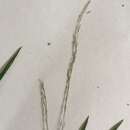Comprehensive Description
(
Inglês
)
fornecido por North American Flora
Muhlenbergia tenuiflora (Wilid.) B. S. P. Prel. Cat. N. Y
67. 1888.
Agroslis tenuiflora Willd. Sp. PI. 1: 364. 1797.
Apera tenuiflora Beauv. Agrost. 151. 1812. (Based on Agroslis tenuiflora Willd.) Trichochloa longiseta Trin. Fund. Agrost. 1 17. 1820. (Based on Agroslis tenuiflora W'illd. Erroneously given as T. longiflora Trin. by Kunth, Enum. PI. I: 601 1833.) Cinna tenuiflora Link, Enum. 1: 71. 1821. (Based on Agroslis tenuiflora Willd.) Muhlenbergia Willdenowii Trin. Gram. Unifl. 188. 1824. (Based on Agroslis tenuiflora Willd.) Trichochloa tenuiflora Sweet. Hort. Brit. 443. 1826. (Based on Agroslis tenuiflora Willd.) Podosaemum tenuiflorum Link. Hort. Berol. 1: 82. 1827. (Based on Agroslis tenuiflora Willd.) Muhlenbergia tenuiflora variabilis Scribn. Rhodora 9: 18. 1907. (Type from Chimney Mountain, North Carolina, Biltmore Herbarium 654a.)
Similar to M. sobolifera in habit ; culms often more robust, more or less retrorsely scabrouspubescent at and below the nodes; sheaths more or less scabrous or short-pilose; blades mostly 10-18 cm. long and 6-10 mm. wide, scabrous; panicles averaging longer than in M. sobolifera; spikelets (excluding awns) 3-4 mm. long, the glumes about half as long, broad at base, abruptly acuminate, scaberulous; lemma narrow, pubescent toward the base, tapering into a slender straight awn 3-10 mm. long.
Type locality: North America.
Distribution: Rocky woods, Ontario and Vermont to Iowa, and southward to Virginia, Tennessee, and Oklahoma.
- citação bibliográfica
- Albert Spear Hitchcock. 1935. (POALES); POACEAE (pars). North American flora. vol 17(6). New York Botanical Garden, New York, NY
Physical Description
(
Inglês
)
fornecido por USDA PLANTS text
Perennials, Terrestrial, not aquatic, Rhizomes present, Rhizome elongate, creeping, stems distant, Stems trailing, spreading or prostrate, Stems nodes swollen or brittle, Stems erect or ascending, Stems geniculate, decumbent, or lax, sometimes rooting at nodes, Stems solitary, Stems terete, round in cross section, or polygonal, Stems branching above base or distally at nodes, Stem nodes bearded or hairy, Stem internodes hollow, Stems with inflorescence less than 1 m tall, Stems, culms, or scapes exceeding basal leaves, Leaves mostly basal, below middle of stem, Leaves mostly cauline, Leaves conspicuously 2-ranked, distichous, Leaves sheathing at base, Leaf sheath mostly open, or loose, Leaf sheath hairy, hispid or prickly, Leaf sheath and blade differentiated, Leaf blades linear, Leaf blades 2-10 mm wide, Leaf blades 1-2 cm wide, Leaf blades mostly flat, Leaf blades mostly glabrous, Leaf blades scabrous, roughened, or wrinkled, Ligule present, Ligule an unfringed eciliate membrane, Inflorescence terminal, Infloresc ence a contracted panicle, narrowly paniculate, branches appressed or ascending, Inflorescence solitary, with 1 spike, fascicle, glomerule, head, or cluster per stem or culm, Inflorescence branches more than 10 to numerous, Flowers bisexual, Spikelets pedicellate, Spikelets laterally compressed, Spikelet less than 3 mm wide, Spikelets with 1 fertile floret, Spikelets solitary at rachis nodes, Spikelets all alike and fertille, Spikelets bisexual, Spikelets disarticulating above the glumes, glumes persistent, Spikelets disarticulating beneath or between the florets, Rachilla or pedicel glabrous, Glumes present, empty bracts, Glumes 2 clearly present, Glumes equal or subequal, Glumes shorter than adjacent lemma, Glumes 1 nerved, Glumes 3 nerved, Lemmas thin, chartaceous, hyaline, cartilaginous, or membranous, Lemma similar in texture to glumes, Lemma 3 nerved, Lemma glabrous, Lemma apex acute or acuminate, Lemma distinctly awned, more than 2-3 mm, Lemma with 1 awn, Lemma awn less than 1 cm long, Lemma awn 1-2 cm long, Lemma margins thin, lying flat, Lemma straight, Callus or base of lemma evidently hairy, Callus hairs shorter than lemma, Palea present, well developed, Palea membranous, hyaline, Palea about equal to lemma, Palea 2 nerved or 2 keeled, Stamens 3, Styles 2-fid, deeply 2-branched, Stigmas 2, Fruit - caryopsis, Caryopsis ellipsoid, longitudinally grooved, hilum long-linear.
Muhlenbergia tenuiflora: Brief Summary
(
Vietnamita
)
fornecido por wikipedia VI
Muhlenbergia tenuiflora là một loài thực vật có hoa trong họ Hòa thảo. Loài này được (Willd.) Britton, Stern & Poggenb. mô tả khoa học đầu tiên năm 1888.
- licença
- cc-by-sa-3.0
- direitos autorais
- Wikipedia tác giả và biên tập viên

